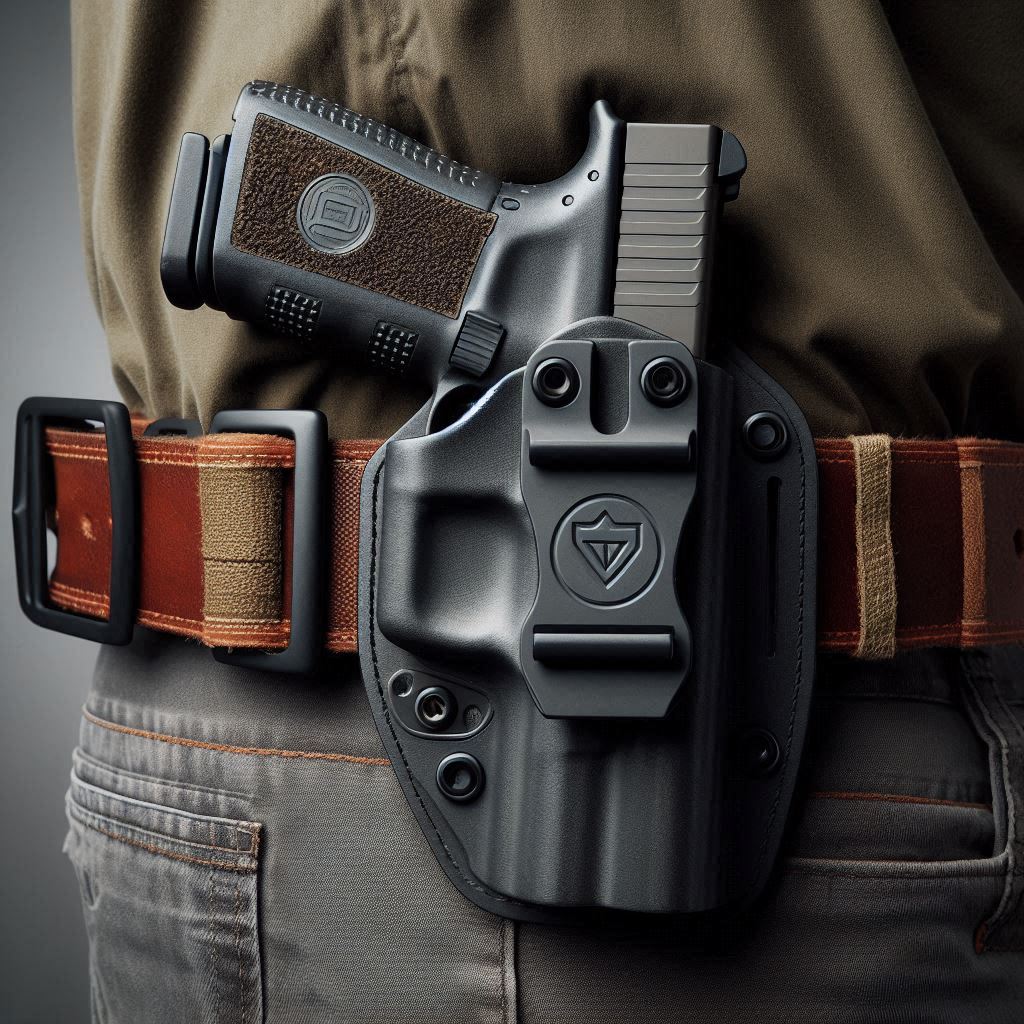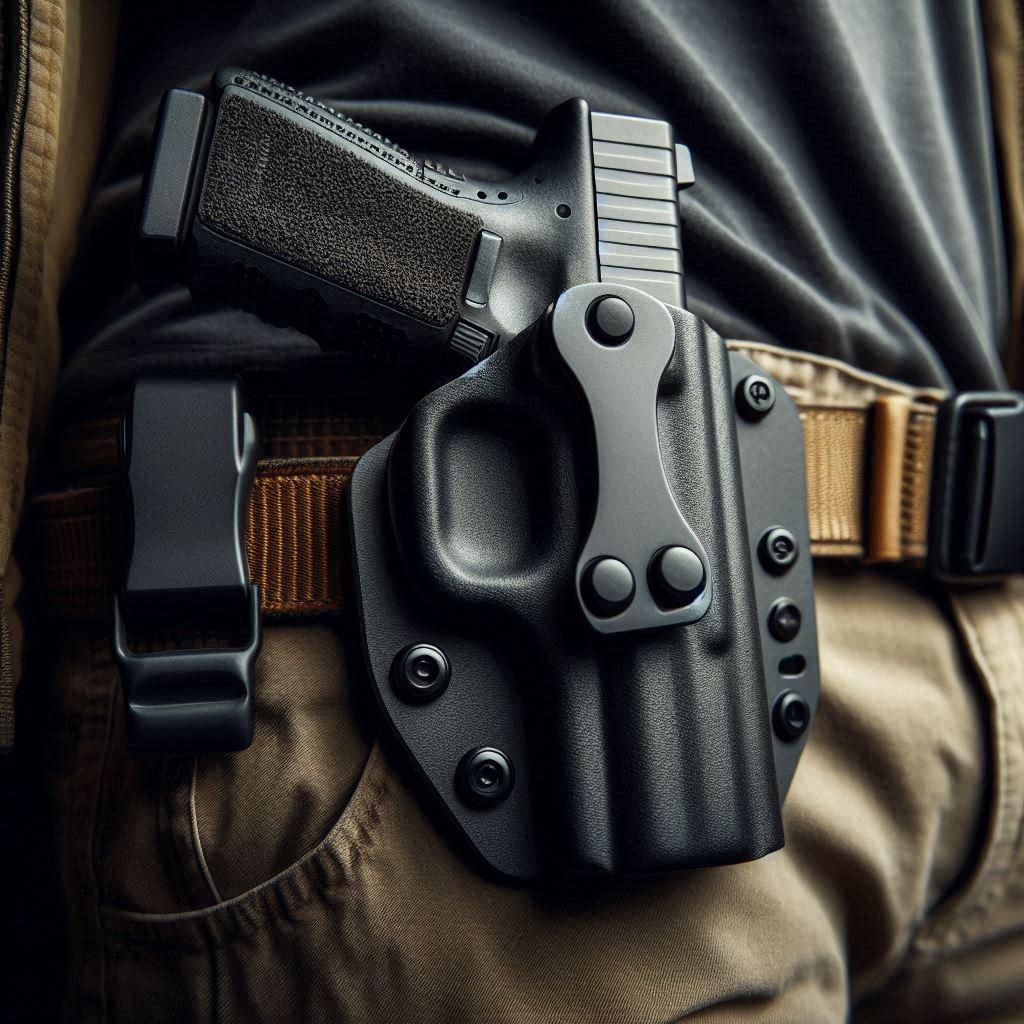OWB Paddle Holster
When choosing an OWB Paddle Holster, you’re considering a reliable and practical choice for carrying your firearm, offering a blend of comfort, convenience, and customizable design.
OWB holsters have transformed markedly since their origins, now made from durable materials like Kydex and high-quality nylon.
With various paddle designs available, such as narrow, wide, and 360-degree adjustable, you can find a holster that suits your needs.
By learning more about OWB paddle holsters’ technical characteristics, performance advantages, and practical applications.
you’ll gain a deeper understanding of how this style can enhance your carrying experience and provide superior comfort.
View Official Website
Key Takeaways
- OWB paddle holsters offer superior weight distribution and comfort during extended carry periods.
- They are suitable for open carry, concealed carry, range practice, and outdoor activities.
- Key retention features include adjustable tension mechanisms and model-specific molding for secure fit.
- OWB paddle holsters provide easier concealment with outerwear and reduced skin contact discomfort.
- They offer faster weapon draw capabilities with minimal clothing interference and reduced body friction.
History of OWB Holsters
View Official Website
When it comes to carrying firearms, outside-the-waistband (OWB) holsters have been a popular choice for many shooters and law enforcement officers.
You might be surprised to learn that OWB holsters have been around for centuries, with their origins dating back to the early days of firearms.
Leather was a primary material used in these early holsters, providing a durable and convenient way to carry a gun.
The early designs also featured molded contours for maximum concealment and comfort, as well as sweat control measures for unmatched comfort during extended carry superior weight distribution.
As firearms technology advanced, so did the design of OWB holsters. The military played a significant role in the development of modern OWB holsters.
During World War II, the military issued holsters to soldiers, which were designed to be functional and practical. These early military holsters laid the foundation for the OWB holsters you see today.
The military’s influence on OWB holster design is still evident, with many modern holsters incorporating features such as adjustable retention and durable materials.
Today, OWB holsters are used by law enforcement, military personnel, and civilians alike, offering a reliable way to carry a firearm outside the waistband.
Types of Paddle Holsters
Carrying a firearm with a paddle holster can be an excellent option, as it offers a great balance between comfort and accessibility – but you have to choose the right type.
When it comes to paddle holsters, there are several types to evaluate, each catering to different preferences and needs.
The most common type is the open-top paddle holster, which features an open design allowing for quick draw and re-holstering. This type is ideal for those who prioritize speed and ease of use.
Some popular options, such as the Tulster Contour design, also offer features like a 360-degree adjustable paddle, allowing for customization of cant and ride height.
Additionally, premium materials like precision-molded Kydex provide secure retention and minimize risk of unintentional dislodging or printing.
On the other hand, the closed-top paddle holster provides a more secure fit, as it fully covers the firearm, offering increased protection against accidental discharges.
The paddle design itself also varies, with some holsters featuring a narrow paddle and others a wider one. The width of the paddle affects the comfort levels and stability of the holster.
A wider paddle often provides better stability, but may be less comfortable for those with smaller waists. Conversely, a narrow paddle may be more comfortable but may not offer the same level of stability.
Key Features and Benefits
Considering the various types of paddle holsters available, you’ll want to focus on the pivotal features and benefits that set them apart. A well-designed paddle holster offers you a sense of security and confidence, knowing that your firearm is secure and easily accessible.
When it comes to paddle positioning, look for a holster that allows you to adjust the angle and height to fit your body and preferred draw style.
This guarantees a smooth, natural draw and minimizes the risk of printing. Also, it’s imperative to evaluate the construction of the holster, as a Kydex construction provides durability and resistance to water and sweat damage Kydex construction.
A paddle holster with a robust design can also provide a high level of retention and safety, making it ideal for open carry or range use.
The comfort design of a paddle holster is also paramount. You’ll want a holster that distributes the weight of your firearm evenly, reducing pressure points and discomfort.
A contoured design that fits snugly against your body will also help to prevent the holster from shifting or moving around.
By choosing a paddle holster with a focus on comfort and adjustability, you can guarantee a secure and comfortable carry experience that allows you to move freely and confidently.
This, in turn, will help you feel more connected to your firearm and prepared for any situation.
View Official Website
Choosing the Right Material
Diving into the world of paddle holsters, you’ll soon realize that the material it’s made of can make or break your carrying experience.
You want a holster that’s both durable and flexible, allowing you to move freely while keeping your firearm secure.
Material durability is paramount in this regard, as it guarantees your holster can withstand the rigors of daily wear and tear.
Look for materials like Kydex or high-quality nylon, which offer exceptional strength and resilience. For instance, Kydex holster construction provides a lightweight yet robust option that can be molded to fit specific firearms, such as Glocks.
Furthermore, Kydex holsters are often crafted to precise specifications, allowing for a snug fit that promotes secure retention.
Holster flexibility is also critical, as it allows you to adjust the holster to your body’s unique contours. A flexible holster will distribute the weight of your firearm evenly, reducing fatigue and discomfort.
When choosing a paddle holster, consider the type of material used and its flexibility. A holster that’s too stiff may cause discomfort, while one that’s too flexible may compromise retention.
By selecting a holster with the right balance of durability and flexibility, you’ll be able to carry your firearm with confidence and comfort.
This balance is key to a great carrying experience, and it’s imperative to prioritize it when choosing a paddle holster.
How to Wear an OWB
Most people find that wearing an outside-the-waistband (OWB) paddle holster is relatively straightforward.
To wear one, start by positioning the holster on your hip, where you’d typically wear a belt.
Verify the paddle is seated snugly against your body and the holster is at a comfortable height, taking into account the adjustable cant angle and ride height adjustments for optimized concealment/accessibility.
Experiment with daily positioning to find what works best for you. Some people prefer to wear their OWB holster at 3 o’clock, while others prefer 4 or 5 o’clock. It’s crucial to weigh your body type, clothing, and lifestyle when choosing a position.
If you have a larger build, you might prefer a slightly more forward position to prevent the gun from digging into your body. Adjust the paddle holster’s retention and ride height to suit your needs.
Advantages Over Other Holsters
As you explore the world of OWB holsters, you’ll quickly discover they offer several advantages over other types of holsters.
When it comes to comfort levels, OWB holsters are often preferred for their ability to distribute the weight of the firearm more evenly.
This is particularly beneficial for those who carry their gun for extended periods. In contrast, IWB holsters can dig into your skin and cause discomfort, especially if you’re not used to carrying a gun.
Another significant advantage of OWB holsters is their versatility in concealment strategies. While they can be more visible than IWB holsters, OWB holsters can be easily concealed with a jacket or a loose-fitting shirt.
This makes them a great option for those who want to be able to easily access their gun while still maintaining a level of concealment. Additionally, OWB holsters often have adjustable retention, allowing you to customize the fit to your specific needs.
This versatility and comfort make OWB holsters a popular choice among those who prioritize both functionality and comfort.
Frequently Asked Questions
Can I Use an OWB Paddle Holster for Left-Handed Shooters?
You’re a left-handed shooter and you’re wondering if you can adapt. Yes, you can use a paddle holster, but you’ll need to find one with a reversible design or adjust the grip angle to fit your left hand.
Are OWB Paddle Holsters Suitable for Concealed Carry Permits?
When carrying concealed, you prioritize comfort without sacrificing security. For your permit, consider a holster that balances carry comfort and positioning, allowing easy access while keeping your firearm secure, a key factor in responsible carry.
Can I Wear an OWB Paddle Holster With a Suit Jacket?
Just like a perfectly tailored suit, your concealed carry setup should be seamless. You can wear a paddle holster under a suit jacket, but jacket retention is key to maintaining suit compatibility and a smooth, discreet draw.
How Do I Clean and Maintain an OWB Paddle Holster?
To keep your gear in top shape, clean and maintain it regularly. Use a soft cloth to wipe down the holster, then apply leather conditioning to keep it supple and prevent cracking, ensuring proper holster alignment.
Are OWB Paddle Holsters Compatible With All Gun Models?
When pairing a gun with a holster, you’ll find that paddle versatility is key. Not all guns match every holster. However, many holsters offer adaptation options, ensuring you can find a compatible fit, no matter the gun model.


